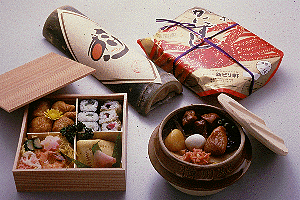- Dining in Japan
- If no meals are included in your budget accommodation charge, it's
time to scout around for the right place to dine out. Tokyo alone has no
less than 60,300 restaurants. Menus range from haute cuisine to cafes and
coffee shops that serve light snacks extremely easy on the purse strings.
But there are modest dining spots where the food is hearty and the tug on
the budget just as readily digestible. Even in the priciest districts such
as Ginza-Hibiya, quite a few restaurants are recommendable for the foreign
visitor interested in budget dining. We will list such restaurants in major
cities across the country under "List of Restaurants Recommendable
to Tourists" .
- Affordable restaurants abound in downtown office building basements,
the dining floors of department stores, urban shopping centers, and the
underground malls of the busiest railway stations.
At lunchtime, office workers crowd these dining spots. Many order teishoku,
a low-priced complete meal on a tray. Most restaurants in the moderate to
inexpensive price range have realistic plastic models of their dishes, with
prices, in a showcase outside the entrance. If you don't know what to order,
point to the dish you want to try. By the way, the models of dishes are
also popular as souvenir. If you want them, you can have at Kappabashi in
Tokyo or at Douguyasuji in Osaka.
Some restaurants have bilingual (Japanese and English) menus, and you can
use JNTO's "Tourist's Handbook " as a handy phrase book for dining
out. Paperback guidebooks to inexpensive Japanese dishes are available at
major bookstores.
For people in a hurry, noodle stands, coffee shops, fastfood outlets and
vending machines provide a variety of food and drink at very low cost.
At most restaurants, you receive a bill and pay as you leave. A few have
you buy a meal coupon in advance and hand it to the waiter or waitress.
Payment is made in cash except when credit cards are accepted. Inexpensive
restaurants, coffee shops and fast-food outlets accept cash only.
-
Novelties
- Box lunches, some unique to a particular area, are sold aboard trains
and at railway stations.

- "Morning Service"served at numerous coffee shops (kissaten)
typically consists of coffee, toasts and a boiled egg is perhaps the most
reasonable breakfast.
- Streetside "yatai" stalls, some with stools, offer inexpensive
taste treats and a chance to rub shoulders with the locals.
- Dinner-shows at deluxe hotels combine fine food and live entertainment
for that one evening you may want to splurge.
- Convenience stores, which abound in every city, have sandwiches, box
lunches and other cooked dishes you can take out.
- Department store basements are great places to sample many kinds of
food for free.
- Kaiten Sushi: Customers sit at a round counter and receive low-priced
sushi on a circling conveyor belt.
How to Eat
If you are not familiar with chopsticks, dining at Japanese or other
Asian cuisine restaurants may present a challenge. But once mastered, eating
with this simple instrument is a genuine pleasure, since you are not confronted
with a variety of unfamiliar eating utensils.
An oshibori towel, in a wrapper or on a small tray, gives you a chance to
wipe your hands (or even your face) before you begin the meal.
Except in Chinese restaurants that provide plastic chopsticks, you eat with
wooden chopsticks that come in a paper wrapper. Take them out, split them
in half, and hold the two halves in one hand with your thumb, forefinger
and middle finger, as if holding two pencils. Then let the middle finger
slip between the two sticks. One stick will rest between the forefinger
and middle finger, the other between the middle and ring fingers. Watch
how other people manipulate the sticks to figure out how to pick up pieces
of food correctly.
To deal with soup, pick up the small bowl with one hand and sip from the
edge of the bowl. You can dip your chopsticks into the soup to pick up small
chunks of bean curd or thin slices of seaweed.
Noodles served on a wooden tray are simply picked up in bite-size portions.
If served in a hot broth, alternate between picking them up and lifting
the bowl to sip the broth. Slurping is a sign of a good appetite and eating
with pleasure, and is in this instance, perfectly acceptable.
Back to LOVE INDONESIA PHILATELY

